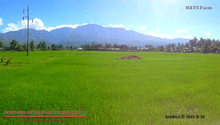Mount Madia-as
Mount Madia-as (also called Madja-as) is a dormant volcano, it is the highest peak in the island of Panay Philippines and the second highest mountain in the Visayas region, after Mount Kanlaon in Negros island. With an elevation of 6,946 feet (2,117 meters) above sea level. Mount Madia-as is ranks 63rd highest in List of islands by highest point in the world. It is famous for its diverse flora and fauna and 14 waterfalls down to its slopes.

Geography and history
Located in Culasi town in the province of Antique, it is part of Central Panay Mountain Range the longest mountain ranges in the island. The mountain has been regarded as one of the most sacred abodes in the Visayas since ancient times, as it is the repository of Sidapa's ancient sacred tree that is used to measure mortal lives. The god of meteors, Bulalakaw, and supreme goddess of the Hiligaynon, Kanlaon, also lived in the mountain prior to their change of abode. Pandaki, god of second chances, is also said to occasionally visit the mountain.
Background
Its summit is 2,117 metres (6,946 ft) above sea level, it is covered by misty forest. In Kinaray-a, the name means "high" or "lofty". The name of the mountain is also associated with the Kedatuan of Madja-as, a royal state confederation in Panay which existed from 1200 AD to 1569 AD.[1] It is located in the town of Culasi in Antique Province. The legendary mountain of Madia-as has been part of Antiqueño's culture, history and literature. It has a total of 14 waterfalls and the source of three major rivers in Northern Antique Dalanas River, Tibiao River, Bacong River and neighboring province of Aklan the tributary of Aklan River the Madalag River. One can see some of the biggest waterfalls like white strands in the slopes of the mountain. To the southeast Mount Madia-as facing on the rival Mount Nangtud the second highest peak in Panay separated by Dalanas River.
Mythology
According to Visayan mythology, the mountain is home to Sidapa, the handsome and robust god of death and war who wore a crown made of golden horns. Sidapa is believed to possess a very tall tree where he measures the lives of all the new-born, and places a mark on the tree. When the person's stature equals the mark provided, the person dies immediately.[2] Afterwards, Sidapa will reap the kalag (soul) of a person and bring it to Magwayen, who in turn brings the soul to Salud or Saad (place of the dead). Sidapa is said to determine the life force of a person by using magical trees in his mountain home.[3]
Bulalakaw, the god of meteors, also lived in the mountain. Sidapa and Bulalakaw are known to be good friends. Bulalakaw later chose to dwell in the sky to formally take on the role as god of meteors. Pandaki, the god of second chances, is said to occasionally visit Sidapa, who he is very fond of and loyal to. The supreme goddess, Kanlaon, is believed to have lived in Mount Madia-as for some time as well, however, she later transferred her abode to Mount Kanlaon in Negros island after the Hiligaynon epic heroes Kan and Laon slayed the dragon-like monster that lived in Mount Kanlaon.[4]
References
- "Mt. Madjaas". Pinoy Mountaineer. March 6, 2009. Archived from the original on May 27, 2017. Retrieved May 27, 2017.
- Cf. Blair, Emma Helen & Robertson, James Alexander, eds. (1903). The Philippine Islands, 1493–1803. Volume 05 of 55 (1582–1583). Historical introduction and additional notes by Edward Gaylord Bourne. Cleveland, Ohio: Arthur H. Clark Company. ISBN 978-0554259598. OCLC 769945704. "Explorations by early navigators, descriptions of the islands and their peoples, their history and records of the catholic missions, as related in contemporaneous books and manuscripts, showing the political, economic, commercial and religious conditions of those islands from their earliest relations with European nations to the beginning of the nineteenth century.", pp. 129 and 131.
- http://precolonailphilippinesmyths.blogspot.com/2016/01/sidapa.html
- Isabelo de los Reyes y Florentino, Las Islas Visayas en la Época de la Conquista (Segunda edición), Manila: 1889, Tipo-Litografía de Chofké y C.a, p. 41.